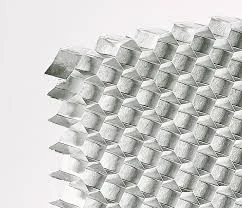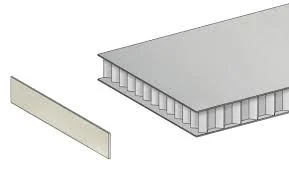Aluminum Honeycomb Blind Plate: A Lightweight Solution for Strong and Durable Structures
In the world of construction and design, finding the perfect balance between strength and weight is essential. This is where the aluminum honeycomb blind plate comes into play. This innovative material offers a lightweight yet robust solution for various structural applications. In this article, we will delve into the features and advantages of aluminum honeycomb blind plates, exploring their unique properties, applications, and benefits in creating strong and durable structures. Join us as we uncover the versatility and potential of this remarkable material.
I. Understanding Aluminum Honeycomb Blind Plates
A. Introduction to Aluminum Honeycomb:
Aluminum honeycomb is a lightweight but incredibly strong material that consists of hexagonal cells made from aluminum sheets. These cells are bonded together, creating a grid-like structure with exceptional strength-to-weight ratio.
B. The Concept of Blind Plates:
Blind plates, in the context of construction, refer to solid plates used to close off or cover openings in structures, where visibility or access is not required. Aluminum honeycomb blind plates combine the benefits of aluminum honeycomb structure with the functionality of blind plates, resulting in a lightweight and durable solution for various applications.

II. Advantages of Aluminum Honeycomb Blind Plates
A. Lightweight Construction:
One of the key advantages of aluminum honeycomb blind plates is their lightweight nature. The honeycomb structure allows for significant weight reduction compared to solid plates, making them ideal for applications where weight is a critical factor.
B. Superior Strength and Rigidity:
Though lightweight, aluminum honeycomb blind plates offer exceptional strength and rigidity. The honeycomb structure provides excellent load-bearing capabilities, allowing for the construction of robust structures without compromising on strength.
C. Excellent Impact and Compression Resistance:
The unique honeycomb design of these plates enhances their resistance to impact and compression forces. The hexagonal cells distribute the forces evenly, minimizing the risk of deformation or failure under heavy loads or impact.
D. Enhanced Sound and Vibration Damping:
Aluminum honeycomb blind plates possess excellent sound and vibration damping properties. The cellular structure effectively absorbs and disperses sound waves and vibrations, contributing to improved acoustic and structural performance.
E. Corrosion Resistance and Durability:
Aluminum is naturally resistant to corrosion, and when combined with the honeycomb structure, it becomes highly durable and long-lasting. This makes aluminum honeycomb blind plates suitable for both indoor and outdoor applications, even in harsh environmental conditions.
III. Applications of Aluminum Honeycomb Blind Plates
A. Aerospace and Aviation:
The aerospace industry extensively utilizes aluminum honeycomb blind plates for various applications, including aircraft interior panels, flooring, ceiling panels, and cargo containers. The lightweight nature of these plates significantly contributes to fuel efficiency and overall weight reduction.
B. Architectural and Construction:
In architectural and construction projects, aluminum honeycomb blind plates find applications in building facades, curtain walls, partitions, and suspended ceilings. Their lightweight nature allows for easier installation and reduces the overall load on the structure, while maintaining strength and durability.
C. Transportation Industry:
Aluminum honeycomb blind plates are utilized in the transportation industry for applications such as vehicle flooring, truck bed liners, and shipping containers. The lightweight and durable properties of these plates contribute to improved fuel efficiency and cargo protection.
D. Industrial Applications:
In industrial settings, aluminum honeycomb blind plates are used for machinery enclosures, equipment covers, and protective barriers. Their strength, lightness, and resistance to impact make them ideal for ensuring safety and security in industrial environments.
IV. Environmental and Sustainability Benefits
A. Energy Efficiency:
The lightweight nature of aluminum honeycomb blind plates reduces energy consumption during transportation and installation. Additionally, their high reflectivity can contribute to energy savings by reducing the need for artificial lighting in illuminated structures.
B. Recyclability:
Aluminum is a highly recyclable material, and the honeycomb structure of these plates does not hinder its recyclability. This makes aluminum honeycomb blind plates an eco-friendly choice, reducing waste and promoting sustainability.
C. Reduced Carbon Footprint:
The use of aluminum honeycomb blind plates in various industries can contribute to reduced carbon emissions due to their lightweight construction, which helps to decrease fuel consumption during transportation and operation.

Conclusion
Aluminum honeycomb blind plates offer a lightweight yet robust solution for creating strong and durable structures. Their unique honeycomb structure provides exceptional strength, impact resistance, and sound damping capabilities. From aviation and architecture to transportation and industrial applications, these plates find their place in a wide range of industries. With their numerous advantages, including weight reduction, corrosion resistance, and recyclability, aluminum honeycomb blind plates are not only functional but also environmentally friendly. Embracing this innovative material can lead to the creation of sustainable and efficient structures that meet the demands of modern construction and design.
- Art
- Causes
- Crafts
- Dance
- Drinks
- Film
- Fitness
- Food
- Games
- Gardening
- Health
- Home
- Literature
- Music
- Networking
- Other
- Party
- Religion
- Shopping
- Sports
- Theater
- Wellness


